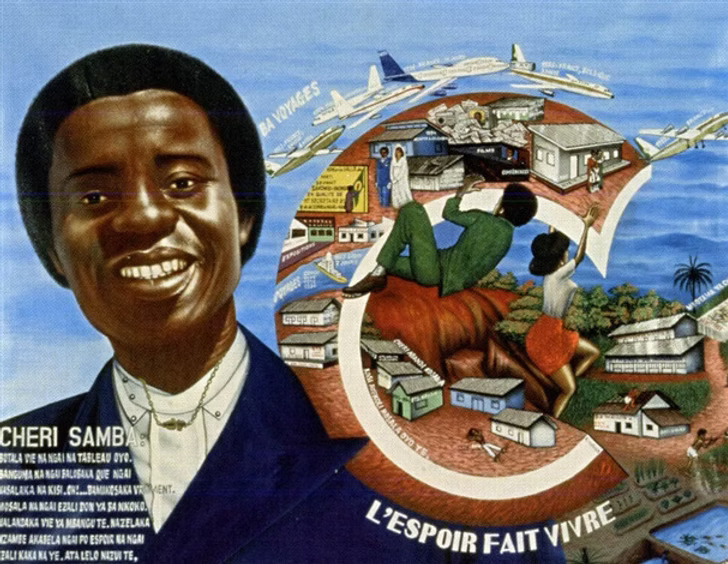Chéri Samba, Le Sida ne sera guérissable que dans 10 ou 20 ans (AIDS will Be Curable only in 10 or 20 years), 1997. Image Source: This is African Art
| “I had noticed that people in the street would walk by paintings, glance at them and keep going. I thought that if I added a bit of text, people would have to stop and take time to read it, to get more into the painting and admire it. That’s what I called the ‘Samba signature.’ From then on I put text in all my paintings.” – CHÉRI SAMBA |
At the break of dawn in Kinshasa, people hear the combined sounds of street vendors making their calls and motorcycle engines churning in the air. Smoked windows allow outside sunlight to enter the studio where artist Chéri Samba prepares his works of art.
He works with painted hands across a piece of sacking cloth that later defines his nonconformist African contemporary style. The studio operates as a stage where practical materials surpass their ordinary functions to create radical visual statements that convey Kinshasa’s vibrant spirit through colorful artistic commentaries. Samba’s creative path reflects the inventive aspects of art that originated from his survival needs. Upon studying billboard painting, he learned from his experience in commercial art how to dominate urban environments containing numerous visual distractions. His initial artistic vocabulary gained strength because he knew about bold visual expression during his early creative experience.
Kinshasa streets during the 1970s offered Samba both creative ideas and raw materials. Due to canvas costing too much, Samba abandoned it and started using sacking cloth, which he transformed into a strong medium for artistic expression. The imprinted rough fibers and imperfections became essential components of his visual approach, which he used to give his art pieces their textured and genuine appearance. Artist Samba chose sackcloth as his material because it served both functional and intellectual purposes in terms of the accessibility of art and its connection to daily life. In 1975, Samba developed his signature artistic method by enacting a complete fusion of the written word within his paintings. His innovative approach to painting began when he unified text and images, creating an original artistic conversation between images and words.
In his artistic creation of “L’espoir fait vivre” (1989), Samba demonstrates his ability to combine socially charged observations with innovative painting techniques. The artwork showcases an extensive urban scene through its vibrant design that builds a powerful visual relationship between its shapes and colors. Samba uses his specialized method of uniting visual elements with textual components to portray optimism against societal and economic obstacles through his artistic work. Every audience member discovers various meanings within this artwork because they each bring their personal beliefs and viewpoints into its complex story.

Chéri Samba, L’espoir fait vivre, 1989. Image Source: This is African Art
Samba has forged a particular connection with his viewers by showing them his personal presence in his artwork. His artworks display his personal image beyond simple self-portraiture since they actively connect with the viewers while engaging with the subject matter. His methodology demonstrates a unique philosophy of art as a participatory force that immerses itself directly into discussions of politics and human existence within society.
The impact of Kinshasa on Samba’s work reaches the fibers of his being, yet his artistic output exists beyond its place of origin. His artwork displays the energetic attributes of the city where he lives and its dual nature, as well as the city’s enduring spirit, which connects to common human emotions. Beautiful colors and stimulating discussions find their place in these markets despite persistent social inequalities that hide in the shadows. His work reveals neighborhood views, which function as essential tools for a global perspective.
Through his artistic approach, he demonstrates innovative techniques in the construction of his work. Samba devotes deliberate thought to materials together with technical execution in each of his paintings. The unique texture of sacking cloth serves as foundational support, and the intense color choices add emotional power to his art. The writer has embedded text throughout images with the intention to both question and lead viewers through intricate stories. Multiple scholars in modern art history investigate how Samba connects his artistic work to different artistic movements. His production has sparked debate about its links with pop art because of his text applications alongside vivid graphics, yet others have recognized his contribution to modern African art-making. Each artwork by Samba fights against easy taxonomies because it draws traditional art forms together to generate brand-new artistic results.
The main accomplishment of Samba’s work verifies his ability to explore delicate social matters by utilizing straightforward artistic elements. He presents themes about social inequality along with political corruption and public health crises through direct expressions that create space for dialogue, not final answers. Samba showed through his AIDS crisis artworks that artistic work can drive essential social dialogues without diminishing creative impact. The international art community has begun to fully understand Samba’s essential contributions. International museums and galleries show his work, but his artistic style continues to express his original intentions of showcasing urban culture and exhibitions. His ability to blend worldwide appreciation with authentic neighborhood roots shows his talent for sharing abstract concepts using personal creative insights.
The creative influence of Samba reaches numerous spaces that exceed his foundational art contributions. At the Centre Georges Pompidou Paris, Samba solidified his artistic worth to global art audiences through his participation in the “Les Magiciens de la Terre” exhibition in 1989. The Paris exhibition served as Samba’s crucial career moment because it presented his unique artistic vision to an international crowd seeking new artistic takes. His acceptance into the 52nd International Art Exhibition at the Venice Biennale in 2007 reinforced his dominant role as a modern art leader. The prestigious exhibitions served as more than personal achievements because they influenced worldwide discussions about African contemporary art.
Artistic students today analyze how Samba combined images with texts while expressing sociopolitical commentary through ordinary materials that create impactful artistic creations. His actual artistic influence transcends technical breakthroughs because he expanded the entire spectrum of contemporary African art and future artistic expression possibilities.
| “My painting is concerned with people’s lives. I’m not interested in myths or beliefs. That’s not my goal. I want to change our mentality that keeps us isolated from the world. I appeal to people’s consciences. Artists must make people think.” CHÉRI SAMBA |
Studio floors and gallery walls in Kinshasa disappear into shadows as the sunset completes its daily journey while Samba’s artistic influence moves forward. Each creation in his practice brings participation to an ongoing dialogue between artists and society about visual storytelling and staying authentic during worldwide audience engagement. Through his work, he proves that artistic transformation arises within any environment because artists can both reveal their proper perspectives and translate them effectively between different cultural groups. Samba used Kinshasa streets as his artistic start-up, yet his impact now extends to worldwide art galleries and indirectly affects consciences across universal borders. Through his work, the artist proves that art possesses the ability to cross borders while honoring its roots because real experiences create universal artistic voices.

Anand Subramanian is a freelance photographer and content writer based out of Tamil Nadu, India. Having a background in Engineering always made him curious about life on the other side of the spectrum. He leapt forward towards the Photography life and never looked back. Specializing in Documentary and Portrait photography gave him an up-close and personal view into the complexities of human beings and those experiences helped him branch out from visual to words. Today he is mentoring passionate photographers and writing about the different dimensions of the art world.





